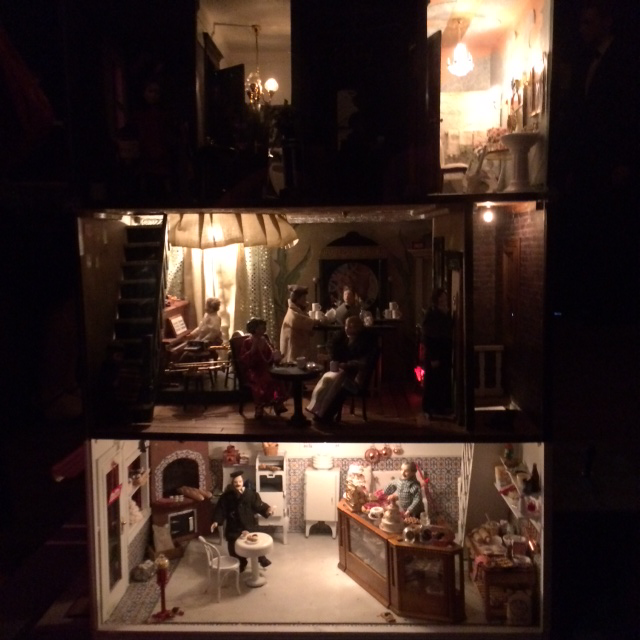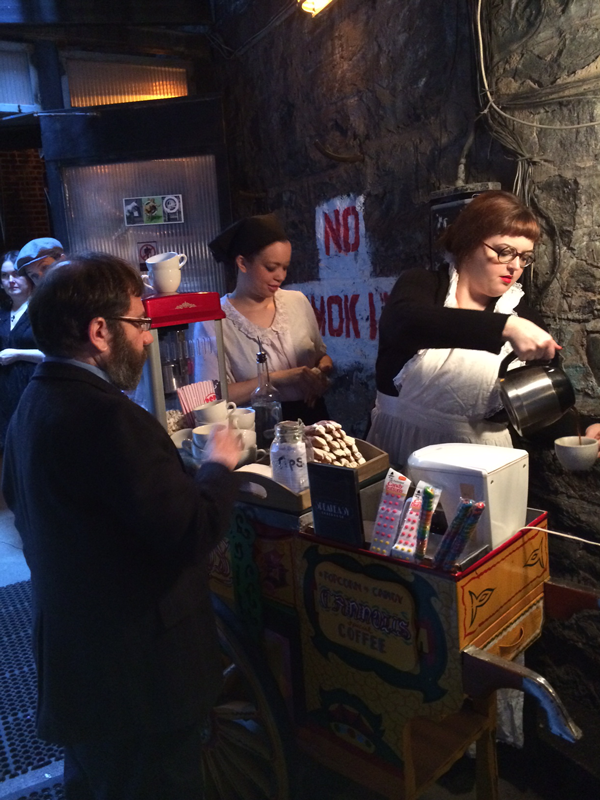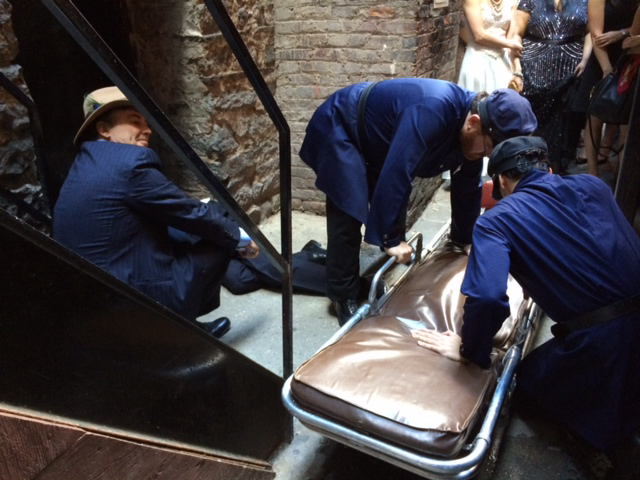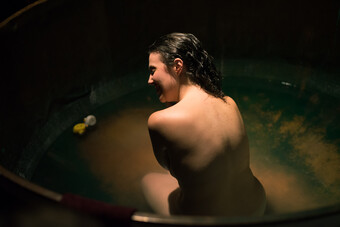A Murder Mystery and a Party in Cynthia von Buhler’s Speakeasy Dollhouse
I knew I was at the right spot when I saw the two actors dressed in vintage cop wear from the Prohibition era at the entrance of 102 Norfolk Street in Manhattan’s Lower East Side. I approached them to enter but they asked for a password I didn’t have and said I had to wait in line. Soon enough, a small crowd of people showed up, some wearing full out flapper garb—lots of pearls, beads, lace, feathers, funny looking hats, and long thin cigarettes—mixed with others who, like me, were wearing nondescript twenty-first century summer gear and flip flops. Two men in gangster suits came by to speak privately to the cops. Then out of the blue they harassed the woman behind me (clearly a performer in a red flapper dress and heels) and very aggressively took her away. “We told you not to come by here,” they yelled in case we weren’t paying attention. Something about a “deal” gone wrong. “I didn’t do anything,” she desperately cried, adding: “Don’t kill me,” as they elbowed their way through some inconspicuous door.
It was by now quite obvious that this was the beginning of the show we were all there to experience: Cynthia von Buhler’s immersive staging of her grandfather’s unsolved 1935 murder. A cross disciplinary artist who spans installation, illustration, children’s books, film, and now theater, Buhler began this project by creating an intricate and fully functioning dollhouse-sized speakeasy, complete with dolls and interior sets, that replicated the characters, places, and situations from this historical and autobiographical murder mystery, hence the name: Speakeasy Dollhouse.

Buhler was inspired to construct her own miniature crime scene set after reading about Frances Glessner Lee’s Nutshell Studies, dioramas originally developed at Harvard’s Department of Legal Medicine in the 1930s which enabled investigators to better assess evidence and crime scenes. After seeing Punchdrunk’s Sleep No More, Buhler decided to recreate the dollhouse with live actors and life-size sets as an immersive experience for audience members. Subtitled The Bloody Beginning, the show is thus the real life replica of Buhler’s original dollhouse sets, which included the speakeasy, the bakery, the morgue, the street scene, and the pre-war apartment where her grandparents lived when her grandfather was shot, which happened to be the very day her grandmother gave birth to a baby girl—Buhler’s mother. What started out as a one-night only performance is now going on to its third year, and is performed three times a month on Saturdays at “Spano’s Club,” better known as The Back Room,” which is one of only two speakeasies still in existence in New York City operating during the Prohibition era.

Before I arrived, I received an email from Cynthia explaining the details of the family saga, complete with four attachments containing newspaper cutouts, police reports, and courtroom proceeding papers. With so many pieces of evidence, I was prepared for an intricate mystery. As we entered the Speakeasy through the narrow corridor one at a time (the bar’s original hidden entrance from 85 years ago), a “fortune teller” character quietly gave us small strips of paper with one instruction (mine was to find Dutch Schultz and persuade him not to kill Thomas Dewey, who would eventually become the forty-seventh governor of New York eight years later in 1943) and one piece of advice: “Be nosy and talk to strangers. The worst possible thing is to sit down and have a drink and just sit in one place. You have to get up and move around.”
Once in the open-air alleyway, there was a flurry of early 1930s NYC street life activity going on: mobster men doing business, playing cards, women gossiping, children playing, a woman selling cannoli and “special” coffee, of the alcohol kind (each at $3 a pop). I felt like I had been plopped in a film set, except I was supposed to be interacting with people. What were we supposed to be doing? Gathering clues? There we were, with our little papers in hand, milling around, trying our best to do what we were told.
I felt like I had been plopped in a film set, except I was supposed to be interacting with people. What were we supposed to be doing? Gathering clues?
My friend met Frank Spano, the grandfather and introduced me. I got a $100 bill from Dutch Schultz (to get me to stop talking about Dewey). I chatted with the wife of Franckie Spano, a cousin of Frank Spanos’s, who told me to check out the bar upstairs and especially the books. Sure enough, the bar displayed lavish vintage decor and the bookcase revolved to uncover the Spanos’ apartment, where 14-year-old Dominick Spano was hanging out, showing off his dollhouse (the speakeasy dollhouse) and his mother, Mary Spano (Buhler’s grandmother), was praying. The women’s restroom doubled as the coroner’s office, where the Chief Medical Examiner was performing an autopsy on the woman that had been standing behind me on line just moments ago. Throughout the two hour evening, we witnessed numerous high energy events, from Frank Spano’s secret love affair, to a full-fledged 1920s striptease show (by burlesque dancer Kat Mon Dieu), to Frank’s actual murder scene (complete with an aria sung by soprano Katie Kat), to his wake and open casket (with Nino Giaimo playing Grimaldi the undertaker), to Mary Spano’s contractions and eventual delivery of baby girl Frances.

As with many immersive, on-location, history pieces, it was the immediacy of the event that was most exciting, while the content and script lagged behind. The energy was high, the transitions between scenes were seamless, as were most of the performances by the main characters. I wish we could have unraveled more intricate clues, had a more challenging mystery to solve. Overall, it reminded me of the environmentally staged pieces that were big box office hits from the late eighties like Tamara, an elaborate mystery spanning three floors at the Seventh Regiment Armory, described as a “party game and murder mystery theme park” by The New York Times, where entertainment, accompanied by the consumption of food and alcohol, reigns supreme.







Comments
The article is just the start of the conversation—we want to know what you think about this subject, too! HowlRound is a space for knowledge-sharing, and we welcome spirited, thoughtful, and on-topic dialogue. Find our full comments policy here